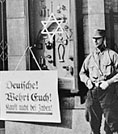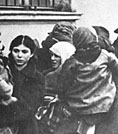 |
Survivors
in this section talk about life before the Holocaust.
They encounter prejudice and discrimination in the form of
anti-Semitism.
They talk about the loss of various rights once anti-Jewish
decrees are established. Some speakers relate
their childhood memories, such as having to leave their homes
as refugees
in Germany to travel to England on the Kindertransport.
Jack Kagan describes occupation
and the arrival of the Einatzkommando
in his town as violence towards the Jews
escalates.
Anti-Semitism
- The
Nazis
used propaganda
campaigns in order to promote Hitler's
virulent hatred of the Jews. This hatred of Jews is known
as anti-Semitism
which can take different forms - institutional, physical
and verbal.
- The
Nazis wanted to portray the Jews as sub-human evil parasites,
inferior beings who were trying to dominate the world. The
Nazis built upon the negative myths concerning Jews passed
down through the Church for centuries. The main myth was
that the Jews were blamed for the death of Christ. This
is why Barbara Stimler refers to Passover
time as an anxious time for Jews, particularly in Eastern
Europe.
Anti-Jewish
Decrees
Germany,
at the time of the Nazi rise to power, had been experiencing
enormous economic and social problems. For example, they had:
- lost
World War One
- experienced
huge unemployment
- there
was huge inflation and economic instability
- they
had to pay compensation to the Allies for starting
World War One
- they
had to adhere to the Treaty of Versailles, whereby
they could no longer have a large army and they
had to give back lan
|
|

|
The German
people were looking for a scapegoat,
and Hitler chose to blame the Jews for Germany's misfortunes.
The Nazi party promised to solve Germany's problems and in
1932, the Nazi party won 37% of the vote.
 The
persecution
of the Jews began systematically almost as soon as Hitler
came to power. The Nazis introduced anti-Jewish decrees, which
gradually eliminated the rights of Jewish citizens and they
were regularly persecuted and humiliated. Many people were
bystanders
and did nothing to condemn the Nazi racial policies. This
may have been due to the fact that they were content with
their other policies, which appeared to improve the disastrous
financial and economic conditions in Germany. People were
also afraid to speak out, as they were terrified of the brutality
of the Nazis. The
persecution
of the Jews began systematically almost as soon as Hitler
came to power. The Nazis introduced anti-Jewish decrees, which
gradually eliminated the rights of Jewish citizens and they
were regularly persecuted and humiliated. Many people were
bystanders
and did nothing to condemn the Nazi racial policies. This
may have been due to the fact that they were content with
their other policies, which appeared to improve the disastrous
financial and economic conditions in Germany. People were
also afraid to speak out, as they were terrified of the brutality
of the Nazis.
The anti-Jewish
decrees were legalised in 1935 when the Nuremberg Laws were
passed. The Nazis believed that the Germans were racially
superior and there was a struggle for survival between them
and what they considered to be inferior races. They saw Jews,
Roma and Sinti (Gypsies), black people and the disabled as
a serious biological threat to the purity of the German-Aryan
race, which they called the 'Master Race'. For the Nazis a
typical Aryan was blond, blue-eyed and tall.
 The
Nuremberg Laws declared that only Aryans could be citizens
of the Third
Reich. All Jews and non-Aryans were excluded from
Germany society. They were stripped of all their rights and
could no longer hold government jobs, own property or run
their own businesses. These laws aimed to isolate and ostracise
Jews so that they became non-citizens and completely defenceless. The
Nuremberg Laws declared that only Aryans could be citizens
of the Third
Reich. All Jews and non-Aryans were excluded from
Germany society. They were stripped of all their rights and
could no longer hold government jobs, own property or run
their own businesses. These laws aimed to isolate and ostracise
Jews so that they became non-citizens and completely defenceless.
Many
Jews had given a great deal to German society. Some German
Jews had been Nobel Prize winners and Jews had contributed
for centuries to all areas of German cultural life. Many Jews
were patriotic Germans and had sacrificed their lives for
their country in World War One. For example, survivor Trude
Levi's father fought for Germany during the 1914-1918 conflict
and was granted medals for serving the country. In her oral
testimony in Topic 1 she describes how her father was told
to return his medals and that his Hungarian citizenship had
been revoked.
Getting
out
- There
were those who managed to leave the country as refugees
but they usually needed money and an entry permit
to
 the country they were fleeing to.
the country they were fleeing to.
- A
conference was held in Evian, France, in July 1935.
32 countries, including Great Britain, met to discuss
the refugee crisis. Most countries refused to accept
more Jewish refugees. They claimed admitting more
refugees would lead to over population, unemployment
and further anti-Semitism.
- Great
Britain insisted that Jewish refugees leaving before
the war must prove there was an available job for
them or that they had sufficient funds to live on.
- In
1938 there was a special scheme called the Kindertransport
allowing 10,000 Jewish children and children of other
Nazi victims into Great Britain. Many countries had
strict quotas and so although many Jews escaped before
the start of the war, some Jews were sent back to
Nazi Europe. A survivor, Anon, in Topic 1 describes
preparing for arrival in England and her treatment
by her foster family. Most of the 9,354 Kindertransport
children never saw their parents again.
|
 |
Occupation
- The
German occupation of Europe began in March 1938 with
the annexation of Austria (Anschluss). The occupation
of Poland on September 3rd 1939 was the trigger for
the start of the Second World War.
 As
other countries were occupied, the Nazis quickly established
the anti-Jewish decrees. These included compulsory
wearing of yellow stars and the establishment of the
ghettos. As
other countries were occupied, the Nazis quickly established
the anti-Jewish decrees. These included compulsory
wearing of yellow stars and the establishment of the
ghettos.- In
June 1941, Hitler broke his pact (10 years of non-aggression)
with the Soviet Union and ordered an invasion using
overwhelming force.
- 2,000
SS, Gestapo and German police were joined by Romanians,
Ukranians, Latvians and Lithuanians who followed the
German army of 5.5 million men.They formed mobile
killing squads called Einsatzgruppen and were responsible
for the murder of approximately 2 million Jews and
thousands of Roma and Sinti( Gypsies). This was the
start of the Holocaust.
|
 |
Click
on the chronology button to see how events evolved.
|
 |